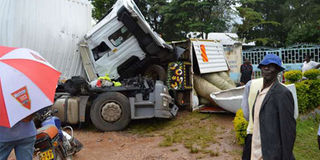We must act now to stem deaths on roads

An accident scene. More than 3,000 people die from avoidable road accidents on Kenyan roads every year. PHOTO | FILE | NATION MEDIA GROUP
What you need to know:
- Pedestrians are putting their lives at risk every time they head out the door.
- More than a quarter of those killed in road accidents are pedestrians.
- Vehicles feed air pollution that is killing seven million people a year and increasing the rate of health problems such as bronchitis, asthma, heart disease, and brain damage.
About 10 people will die in road accidents around the world as you read this article — roughly two every minute. That is 1.3 million dead mothers, fathers, and children in 2016. By 2030, that is almost 30 million lost friends and family members.
Each year we fail to fix the problem of dangerous roads and more cars hit the streets, the number goes up. It is scandalous that we knowingly let the rough equivalent of the population of Australia, Ghana, or Nepal die in just 15 years. Worse still, we accept it knowing there are ways to avoid these road deaths.
Virtually every person has been a pedestrian or a cyclist at one point. In many places, this may be for leisure, but countless people rely on walking and cycling as their main mode of transport.
Such affordable, people-powered options offer huge social, economic, and environmental benefits for urban and rural areas. But pedestrians are putting their lives at risk every time they head out the door. More than a quarter of those killed in road accidents are pedestrians. This number is steadily increasing due to a tragic lack of investment in proper infrastructure.
The fatal consequences of poor mobility design are indirect as well. Transport generates nearly a quarter of all carbon dioxide emissions and is the fastest growing source of greenhouse gases.
Vehicles feed air pollution that is killing seven million people a year and increasing the rate of health problems such as bronchitis, asthma, heart disease, and brain damage.
In Africa, deaths from outdoor air pollution have increased 36 per cent in the past two decades. The associated health care costs amount to $215 billion (Sh21.9 trillion).
DANGEROUS TRANSIT
We can fix the twin problems of dangerous transit and unhealthy emissions with one solution. We plan and invest in better, safer, and cleaner transport options. And make no mistake: it is an investment, not a cost. Very few transport plans factor in the enormous financial burden of health care associated with dangerous streets and polluted skies.
Governments can decide to take the first step, which can be as simple as creating a cycling and walking policy. Many governments already have, and those looking to make progress have a wealth of examples to learn from.
In Bogota, Colombia, the TransMilenio bus system has reduced fatalities along its route by 88 per cent. In Delhi, the bus rapid transit system has reduced the chance of death for cyclists and bus users to near-zero. Each of these mass transit options helps to reduce the number of vehicles on the road, which improves air quality.
In Kenya, many children cannot get to school because they live too far away. With some 500 pedestrians dying in Nairobi each year, it is easy to see why parents are unwilling to risk their child’s life walking. And many of the children who do walk arrive late or tired, especially girls who must also find time and energy for housework.
The Kenyan Government, World Bicycle Relief, and World Vision are changing this by helping local communities distribute and maintain bikes for students. Newly-trained mechanics have jobs. Students arrive on time and ready to learn.
Families can better transport water to their homes and goods to market.
These are only a few examples among dozens that governments — national, regional, and municipal — can learn from and build on.
As the world’s population climbs well past seven billion, we need to design mobility for our people instead of mobility for our cars. There is no time to lose — we lose two more mothers, fathers, children or friends every minute we waste.
Mr Solheim is the executive director of UN Environment Programme.




